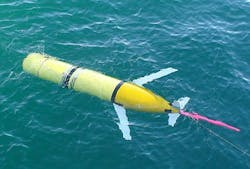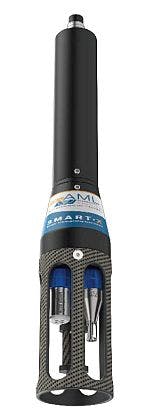MONTEREY, Calif., 13 Sept. 2013. U.S. Navy researchers needed sensors for glider unmanned underwater vehicle (UUVs) to collect oceanographic data and conduct technology demonstrations for the Office of Naval Research (ONR). They found their solution from AML Oceanographic in Sidney, British Columbia.
Officials of the Naval Postgraduate School's Department of Contracting and Logistics in Monterey, Calif., have announced their intention to buy replacement Smart X environmental sensors from AML for the Littoral Glider from Exocetus Development LLC in Anchorage, Alaska.
The Naval Postgraduate School owns and operates several of the unmanned Exocetus Littoral Gliders, which were designed to accommodate older versions of the AML Oceanographic environmental sensors -- including the sensor form factor, the power requirements, the physical wet-end to dry-end interface, and the data stream and recording format.
This purchase upcoming sensor purchase from AML is for the replacement of advanced oceanographic environmental sensors for the autonomous gliders. These sensors are necessary to collect oceanographic data and conduct technology demonstrations for the Naval Postgraduate School's sponsoring agency, the Office of Naval Research.
| Related stories -- NOAA asks industry for long-endurance UUV to profile ocean temperatures and salinity -- Liquid Robotics Wave Glider battles Hurricane Isaac -- Swimming robots. |
The Smart X underwater glider sensors are for the real-time monitoring of environmental parameters, such as temperature, pressure, and sound speed. There are no other sensors that conform to all of these existing requirements without a major re-design of the existing systems, Navy officials say. The estimated cost of the sensors is $30,000.
A sea glider is a long-endurance and long-distance UUV that uses variable ballast to control its depth in the ocean. It works by rising to the surface, adjusting its ballast to make it sink, and then uses control surfaces to propel itself forward and maneuver, in a similar way that a glider aircraft moves through the air.
As sea gliders are designed to operate at a wide variety of ocean depths, they are especially well suited to monitoring different kinds of conditions at different depths, such as temperature, salinity, and many other factors.
Long-endurance sea gliders can navigate using a combination of inertial measurement units (IMU) and GPS receivers. When the glider rises to the surface it sticks an antenna out of the water to get its GPS position. It can track its position while submerged using its IMU and dead reckoning.
The Exocetus Coastal Glider was developed under funding from the Office of Naval Research during a six-year period, during which 18 of the gliders were delivered to the Navy, company officials say.
Exocetus Coastal Gliders were designed to operate in coastal waters where high currents and large water densities occur due mostly to the fresh water entering these coastal waters from rivers. Many other kinds of sea gliders were designed for open-ocean operations. The Exocetus Coastal Glider was designed to add more sensors easily with minimal changes to the glider housing.
The Exocetus Coastal Glider can operate down to depths of 200 meters, which is adequate for most coastal applications. It is designed to operate for as long as 14 days with an alkaline battery pack and for 60 days with a lithium pack.
The glider communicates by Iridium satellite, Service ARGOS, Freewave UHF line-of-sight, and WiFi. Acoustic modems can be added for communication with underwater devices. The AML Smart X sensor suite is a real-time instrument that enables users to change the instrument’s sensor load in the field as necessary.
The Smart X equipped with a sound velocity sensor also is appropriate for sea surface sound velocity measurement for multi-beam systems. The instrument is available in one- or three-sensor configurations.
Navy researchers plan to award a sole-source contract to AML. Although researchers are not asking for competitive bids, companies that believe they have compatible technology that meets all the Navy's requirements have until 18 Sept. 2013 to make their capabilities know.
The solicitation number is N62271-13-Q-1310, and is issued as a request for quote (RFQ). Email quotes to the Naval Postgraduate School's Jennifer Lee at [email protected].
Additional information about the solicitation is online at https://www.fbo.gov/spg/DON/NAVSUP/200/N6227113Q1310/listing.html.
For more information contact AML Oceanographic online at www.amloceanographic.com, Exocetus Development at http://exocetus.com, or the Naval Postgraduate School at www.nps.edu.


